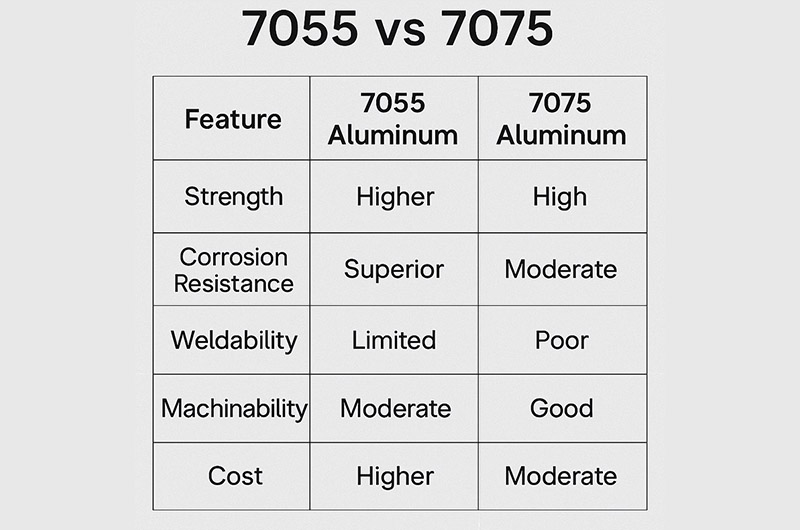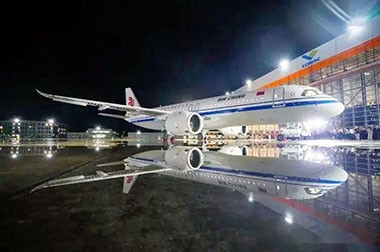7055 vs 7075
7055 and 7075 aluminum alloys both belong to the 7000 series and are primarily composed of zinc. Due to their excellent strength-to-weight ratio, they are widely used in the aerospace and structural fields.
Both 7055 and 7075 are high-strength aluminum alloys suitable for demanding applications, but 7055 offers higher strength and corrosion resistance, making it an ideal choice for critical aerospace components. On the other hand, 7075 has a balanced combination of strength and machinability, making it suitable for various industries.

7055 vs 7075 Summary
| Feature | 7055 Aluminum | 7075 Aluminum |
| Strength | Higher | High |
| Corrosion Resistance | Superior | Moderate |
| Weldability | Limited | Poor |
| Machinability | Moderate | Good |
| Toughness | Moderate fracture toughness | Higher fracture toughness with stronger crack propagation resistance |
| Processability | High quenching sensitivity, prone to deformation | Zr element reduces quenching sensitivity, better process adaptability |
| Primary Use | Aerospace structures | Aerospace, automotive, sporting goods |
| Cost | Higher | Moderate |
7055 vs 7075 Corrosion Resistance and Stress Corrosion Cracking
7055 Corrosion Resistance and Stress Corrosion Cracking
- Due to the addition of zirconium, which stabilizes the microstructure, it exhibits excellent stress corrosion cracking (SCC) resistance.
- Maintains corrosion resistance even in thick-walled components (e.g., aerospace fuselage walls).
7075 Corrosion Resistance and Stress Corrosion Cracking
- Prone to stress corrosion in high-stress environments unless coated (e.g., clad with pure aluminum).
- T73 temper improves SCC resistance but reduces strength.
7055 vs 7075 Heat Treatment and Tempers
7055 Heat Treatment and Tempers
Common tempers: T7751, T77511 (overaged to relieve stress). Best performance can be achieved through Retrogression and Re-Aging (RRA).
7075 Heat Treatment and Tempers
Common tempers: T6 (peak strength), T651 (stress relieved), T73 (enhanced SCC resistance).
RRA treatment can restore T6 strength while improving corrosion resistance.
7055 vs 7075 Chemical Composition
7055 Aluminum Chemical Composition
- Compared with 7075, this alloy contains higher levels of zinc (7.6–8.4%), copper (2.0–2.6%), and zirconium (0.08–0.25%), with lower chromium content (≤0.04%). This composition enhances strength and fracture toughness.
- Primary elements: Zinc (main), Copper, Magnesium, Zirconium.
7075 Aluminum Chemical Composition
- Slightly lower contents of zinc (5.1–6.1%) and copper (1.2–2.0%), but higher chromium content (0.18–0.28%), which improves corrosion resistance. Magnesium (2.1–2.9%) also contributes to its strength.
- Primary elements: Zinc (main), Magnesium, Copper, Chromium.
| Element | 7055 (%) | 7075 (%) |
| Aluminum | 85.9 – 88.5 | Balance |
| Zinc (Zn) | 7.6 – 8.4 | 5.1 – 6.1 |
| Magnesium (Mg) | 1.8 – 2.3 | 2.1 – 2.9 |
| Copper (Cu) | 2.0 – 2.6 | 1.2 – 2.0 |
| Zirconium (Zr) | 0.08 – 0.25 | — |
| Chromium (Cr) | ≤ 0.04 | 0.18 – 0.28 |
| Others | ≤ 0.15 (total) | ≤ 0.15 (total) |
7055 vs 7075 Mechanical Properties
| Property | 7055-T7751 | 7075-T6 |
| Ultimate Tensile Strength | ~593 MPa | ~572 MPa |
| Yield Strength | ~524 MPa | ~503 MPa |
| Elongation at Break | 9–12% | ~11% |
| Fracture Toughness | ~24.2 MPa·√m | ~25 MPa·√m |
| Density | 2.86 g/cm³ | 2.81 g/cm³ |
- 7055: Possesses excellent compressive strength and fracture toughness, making it ideal for load-bearing structures.
- 7075: Offers higher tensile/yield strength in peak-aged tempers (e.g., T6), but lower elongation and toughness compared to 7055.
7055 vs 7075 Key Differences
- Strength: 7055 generally has higher tensile and yield strength than 7075, making it suitable for applications requiring extreme strength.
- Corrosion Resistance: 7055 exhibits superior stress corrosion cracking (SCC) resistance compared to 7075, especially in thicker sections.
- Weldability: Both alloys have limited weldability, but 7075 is more difficult to weld due to its tendency to crack.
- Machinability: 7075 is well-known for its good machinability, while 7055, being a newer alloy, has less available machining data.
7055 vs 7075 Applications
7055 Applications
- Aerospace: Compressive structures (e.g., fuselage frames, wing ribs).
- Thick plates (3-6 inches), where strength and crack resistance are critical.
7075 Applications
- Aerospace: Wing skins, landing gear, missile components.
- Consumer Goods: Used in bicycle frames, climbing gear, firearm components due to high strength-to-weight ratio.
| Alloy Grade | Application Field | Specific Parts/Components | Key Characteristics |
| 7055 | Aerospace | Aircraft wing skins | Ultra-high strength aluminum alloy with excellent corrosion and fatigue resistance, specifically designed for structurally critical parts, suitable for aerospace structures demanding high reliability. |
| Aircraft fuselage frames | |||
| High-strength structural components | |||
| 7075 | Aerospace | Aircraft parts (e.g., joints, reinforcements) | High strength, good machinability, widely used; although not as corrosion-resistant as 7055, its durability can be enhanced through surface treatments like anodizing, making it suitable for multiple applications. |
| Automotive | Gears and drive shafts | ||
| Sporting Goods | Bicycle components, climbing equipment, ski accessories, etc. |
7055 vs 7075 Machinability and Weldability
Both alloys have poor weldability and require special techniques (e.g., friction stir welding).
- 7055: Due to lower quenching sensitivity, it offers better machinability in thick-section components.
- 7075: Slightly easier to machine in the T6 temper, but tool wear is an issue.
7055 vs 7075 Cost and Availability
- 7055: More expensive due to its specialized aerospace applications and higher alloying elements (Zn, Zr).
- 7075: Broadly applicable and cost-effective, suitable for general high-strength applications.






